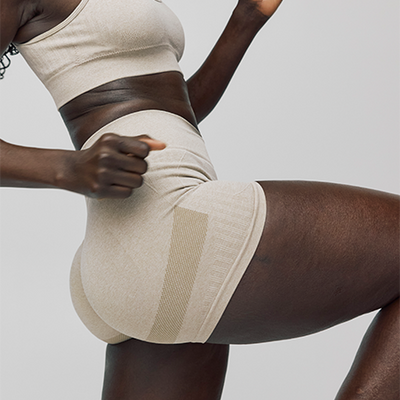

We may know a lot about our bodies, but do you know how high or how low your cervix actually is? It's OK if you don't! Cervix height may not feel simple to figure out — but we're here to help.
“Cervix height is an easily accessible and very useful bit of info that can improve everything from your sex life to your period,” CVS says, “but it’s an absolutely essential part of owning a menstrual cup, too.”
And no, before you think it: Cervix height has nothing to do with how tall or short you are. Even science says so. The height of your cervix truly depends on you, your body and the phase of your cycle that you’re in at any given time.
Do you know how to measure cervix height? Find out how to measure it, below.
Everything You Need To Know About Cervix Height, Explained
First things first: The cervix sits at the base of the uterus. It is the connective opening of the uterus into the vagina.
If you insert your finger into your vagina, feel for your cervix, and then compare how much of your finger can be inserted against a measuring tape, you can determine your cervix height.
-
The average cervix height is between 45-55mm or 1.8”-2.25”.
-
Cervix height reflects the distance from the vaginal opening to the tip of the cervix, as it protrudes into the vaginal cavity.
-
The tip of the vaginal portion of the cervix hangs into the vaginal cavity – it is the sphincter of the uterus.
Cervix height is not to be confused with cervix length. The cervix is a long cylindrical cavity portion of the lower part of the uterus. It is roughly 2-3 cm long and it descends into the vaginal cavity.
The vaginal portion of the cervix lifts and lowers depending on which phase of the menstrual cycle you are in. The cervix length is the measurement of the long cylindrical cavity at the lower part of the uterus. It also changes throughout pregnancy, when it shortens and softens in preparation for labor.
How To Measure Your Cervix Height
Cervix height measuring is done by inserting your index finger into your vagina and feeling for the tip of your cervix – it feels like the tip of a nose.
Step 1: Insert your finger
Touch your finger to this round soft point and make note of how far your finger is inserted.
Step 2: Compare
Compare the amount of your index finger that could be inserted with a measuring tape. This is how many centimeters/inches up your cervix is.
The best time to measure cervix height is during your period when cervix height will be at its lowest.
Step 3: Get an exact measurement
To get an exact measurement, measure cervix height on the first and last day of your period. Note the shortest length. This measurement, in either millimeters or inches, is the height of your cervix.
You might also determine that you have a lower cervix height through trial and error with a menstrual cup. A symptom of low cervix height might include feeling as though you hit a “wall” when trying to insert your cup or that your cup protrudes beyond the vaginal opening leading to irritation.
If you experience any of these symptoms, reach out to our Consumer Experience Team for support. If you haven’t tried a cup or a disc before, measure cervix height before selecting the period product for you.
What It Means to Have a Low Cervix
If you have a low cervix (44mm or 1.4” or less), this means that the distance from the vaginal opening to the tip of the cervix is on the shorter end. This is completely normal! Our anatomy is unique to us and knowing that we have a lower cervix is helpful information to have when selecting menstrual products.
Using a menstrual cup with a low cervix might feel like your cup is sitting lower and sticking out beyond the labia. This might cause irritation in and around the vaginal opening. If you are experiencing any of these symptoms, try a menstrual disc instead.
If you have a lower cervix height (44mm or 1.4” or less), it’s a great option since it has a shallow
catch. It has a shallow catch basin and sits higher up and is positioned directly underneath the cervix in the vaginal fornix around the cervix in the vaginal fornix.
Cervix Heights and The Menstrual Cups That’s Right For You
Imagine wearing a pair of jeans all day that just doesn’t fit quite right. They ride up, they’re too tight, too baggy and just plain uncomfortable. That’s what can happen if you’ve got the wrong menstrual cup.
Luckily, though, your cervix height can help you determine which cup is best for you. Here are DIVA’s options for cups (and even a menstrual disc) based on height, below.
The Cup For a Medium Cervix Height
If you have a medium cervix height, this means that the distance from the vaginal opening to the tip of the cervix is “average” or between 45-55mm (1.8”-2.25”). A menstrual cup like the DIVA Cup Model 1 should fit comfortably without protruding beyond the labia. However, you might also choose to use a menstrual disc. Either way, you can wear both for up to 12 hours of continuous protection.
High Cervix Height
A high cervix range is 55mm (2.25”) and more. Having a high or average height cervix (45-55mm/1.8”-2.25”) works well with a menstrual cup that has a longer catch basin.
The DIVA Cup sits below the cervix, in the vaginal canal and is held in place by the vaginal walls. If you have an average or higher cervix, there should be room for it to sit comfortably in the vaginal canal without extending beyond the vaginal opening.
If you’ve got a slim vaginal canal, we recommend the DIVA Cup Model 0. For those with a wider canal or for those in postpartum, the Model 2 will do the job.
The Signs of a Tilted Uterus & Cervix
Our anatomy is unique to us. It is important to get familiar with it, so that we can decipher what is normal for us from what might be an underlying issue.
A tilted uterus, or retroverted uterus, is a condition in which the uterus is tilted towards the back of the pelvis instead of the front. In most cases, a tilted uterus causes no symptoms and is not felt by the individual. Some people may experience a sense of “fullness” or pressure in the pelvic area, but these sensations are typically not painful.
However, in some cases, a tilted uterus can cause certain symptoms, which may include:
-
Pain or discomfort during intercourse
-
Pain or discomfort in the lower back or pelvic area
-
Difficulty inserting a menstrual cup or disc
-
Painful menstrual cramps
-
Constipation or difficulty with bowel movements
-
Urinary frequency or urgency
-
Difficulty getting pregnant
Many of these symptoms could also be a result of other conditions. It is important to consult with a healthcare provider for proper diagnosis and treatment.
Remember: Information is power! Knowing your cervix height, and becoming more familiar with your own body, will only benefit you — and your periods.













